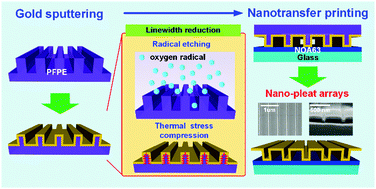Nanotransfer printing of plasmonic nano-pleat arrays with ultra-reduced nanocavity width using perfluoropolyether molds†
Abstract
This study presents a novel process based on nanotransfer printing (NTP) for fabricating gold nano-pleat arrays. A gold film deposited over nano-ridge arrays on a perfluoropolyether (PFPE) mold was transferred directly to an NOA63 film on a glass substrate. The width of the nanocavities on the nano-pleat array can be dramatically reduced compared with the width of the nano-ridges on the mold, thus avoiding the difficulty of replicating extremely small nano-features. The mechanisms of remarkable reduction in the nanocavity width during the gold sputtering process were investigated. A nano-pleat array with a nanocavity width of 20 nm transferred from a PFPE mold with 80 nm features was successfully achieved. The plasmonic properties of the nano-pleat arrays were investigated numerically and experimentally. A sharp dip was found between two coupling modes in the measured spectrum, and its bandwidth was as small as 13.1 nm. Phase dip was used for refractive index sensing, demonstrating a good sensitivity of 525.5 nm per RIU with a figure of merit of 40.1. The proposed fabrication process only involved ion sputter coating of the gold film and one-step NTP. Thus, nano-pleat arrays are promising candidates for surface plasmon sensors.


 Please wait while we load your content...
Please wait while we load your content...